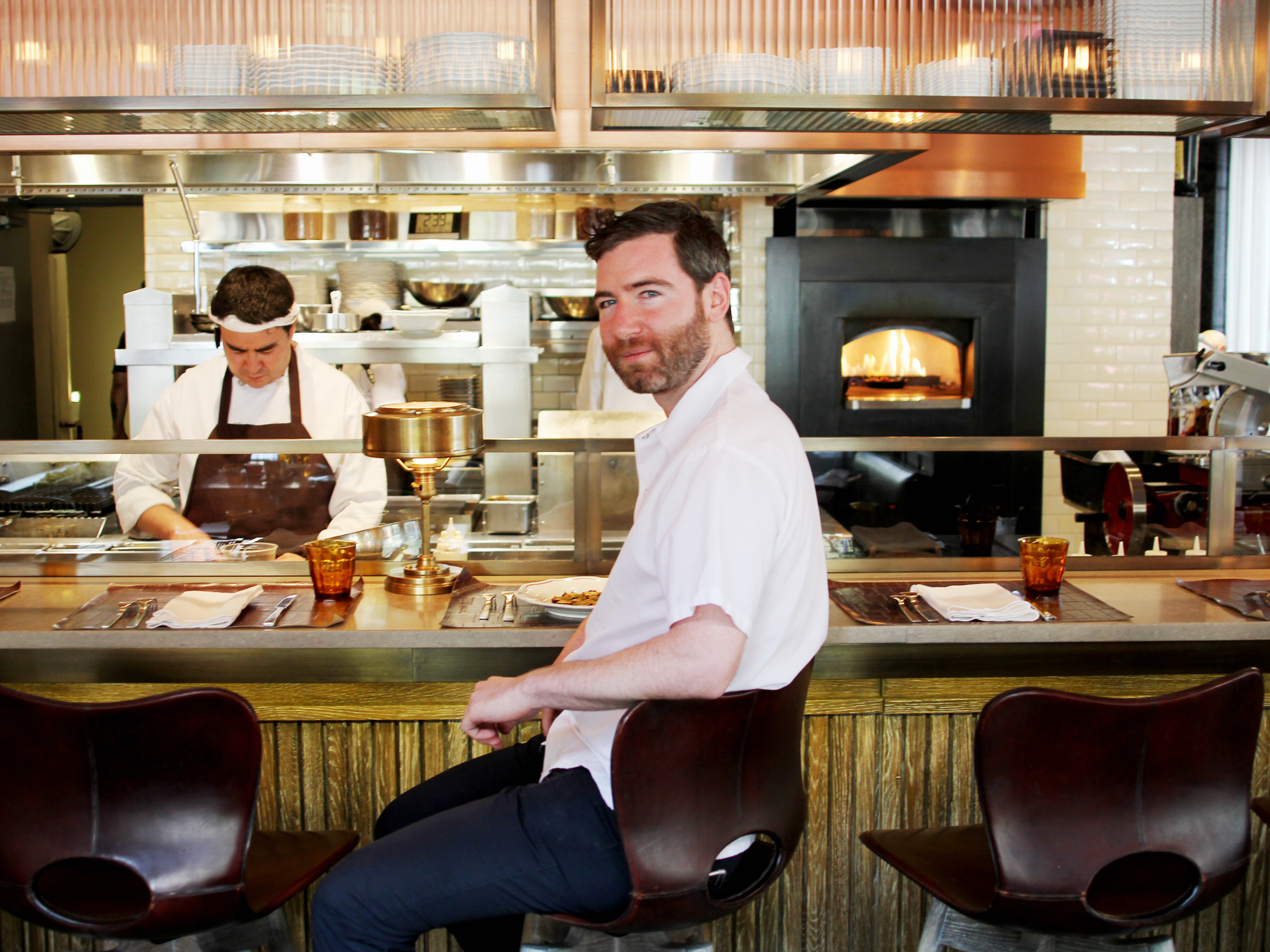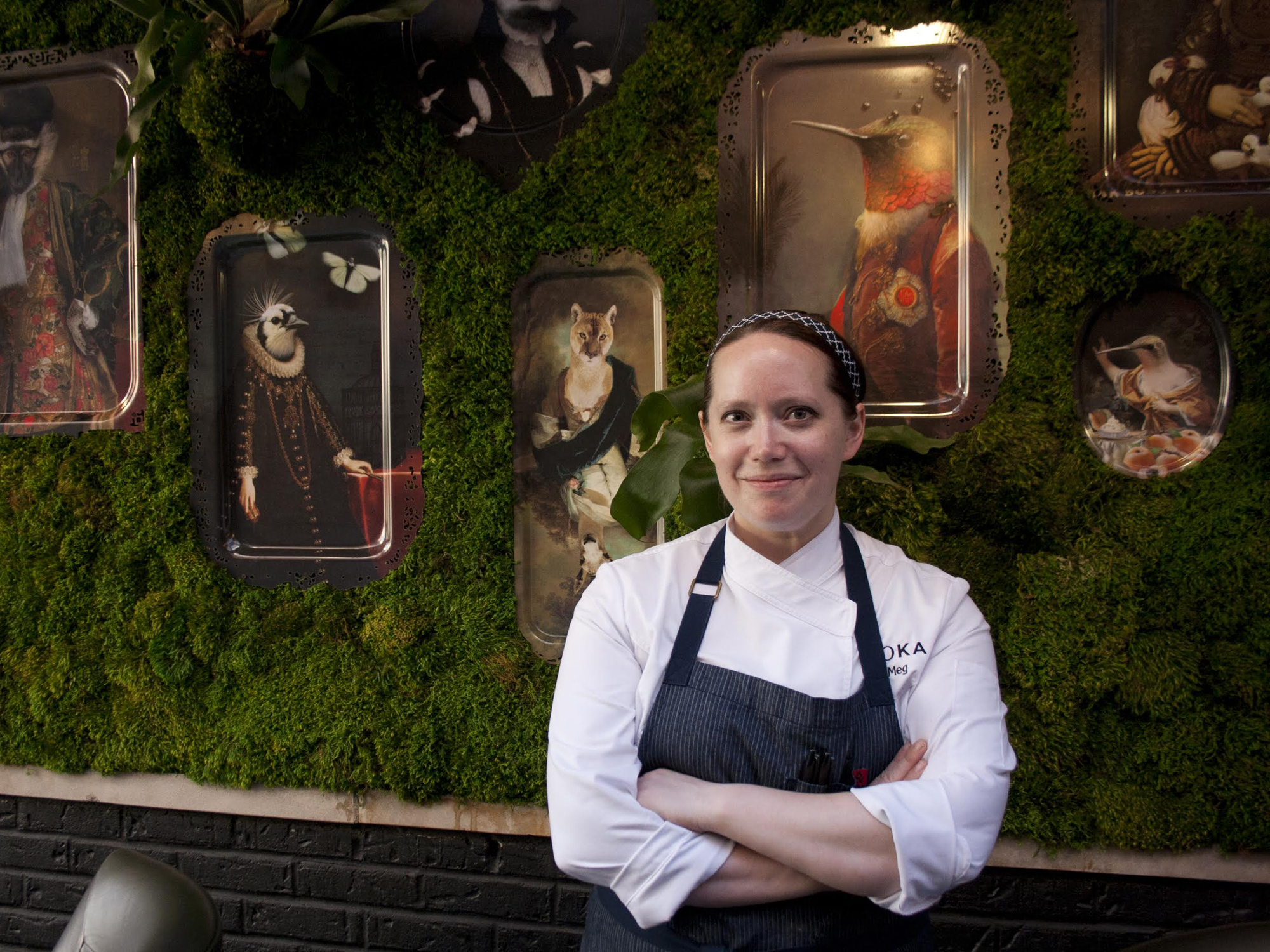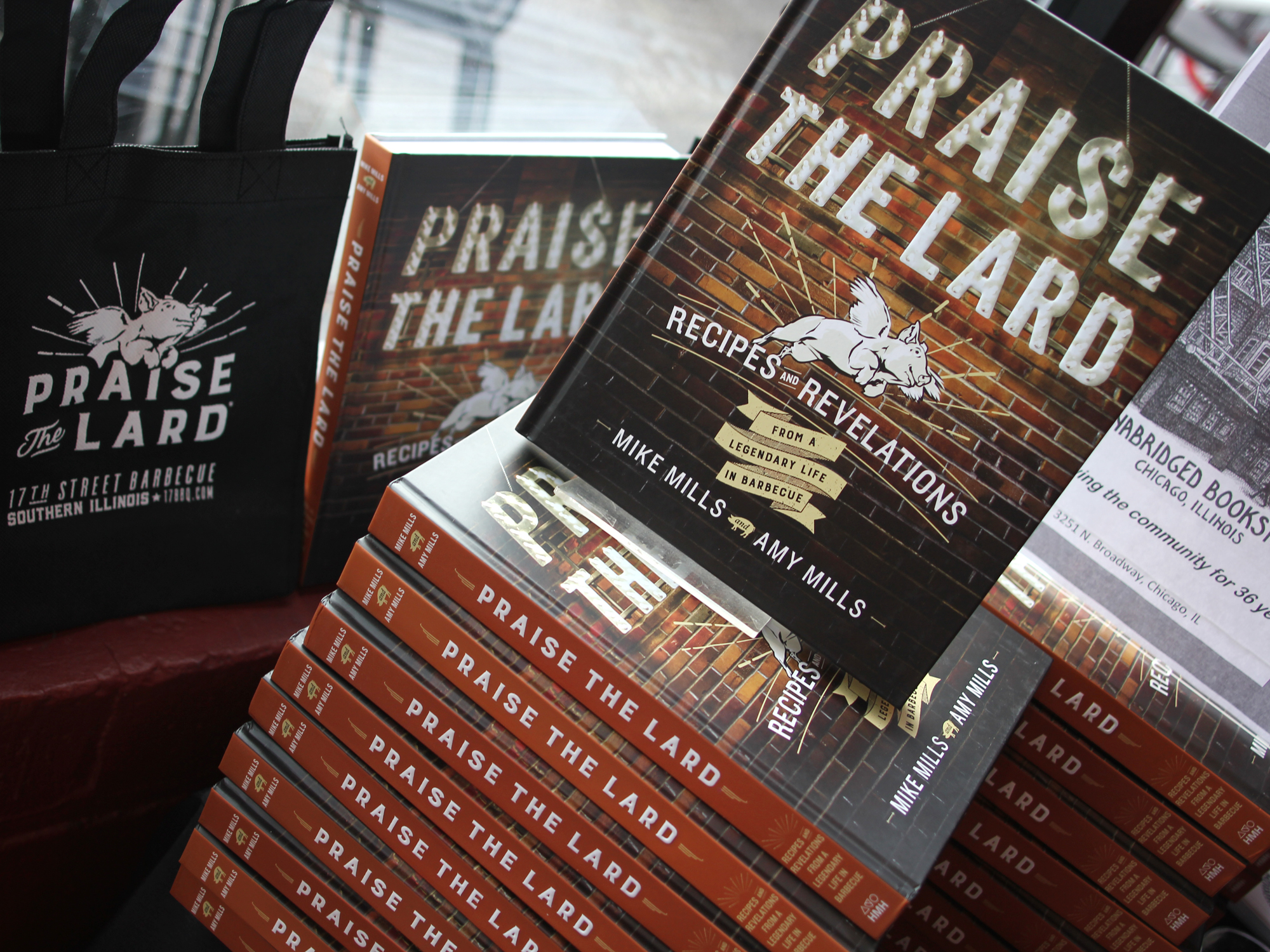A FEW YEARS AGO, THE OWNERS OF SMOQUE were exploring the idea of a downtown location. They looked at one particular space, then occupied by a greeting card store, in a building owned by the Chicago Public Schools. They were ready to make a deal. And then… “The listing agent said, there’s nobody to talk to,” says co-owner Barry Sorkin. “We were ready to make an offer and she said, ‘I don’t have anybody I can submit this to, with the authority to do anything about it.'”
A few years later developer Craig Golden bought the building from CPS, and now the main floor is the wildly popular Revival Food Hall, home to an assortment of artisanal food vendors including Smoque. Who are located in the southeast corner of the building—more or less exactly where the greeting card store used to be.
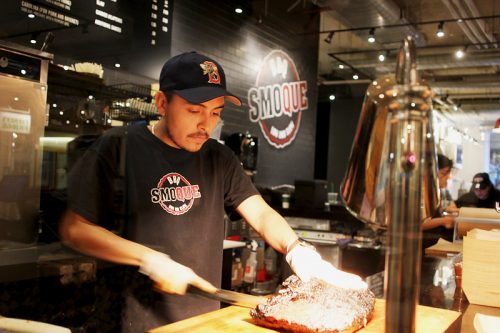
Smoque at Revival Food Hall
Bringing hardwood-smoked barbecue to the Loop still wasn’t easy, however (even though by this point, they were no longer the first—Blackwood BBQ was already doing it). The main problem was that Smoque didn’t want to do was do it commissary-style—cook in a warehouse somewhere and truck it to the serving location.
“We’ve talked to a lot of different kinds of venues over the years—Navy Pier, the airports—and there were a lot of reasons why those didn’t make sense to us. But one of the major reasons was, they were all going to make us commissary,” says Sorkin. “And we all know that when you commissary barbecue, it’s not as good. It’s okay—barbecue travels better than some things, but it’s certainly diminished. And one of the things that appealed to us about these guys when they approached us, was that they were as interested in having us serve a great product as we were.”
“When we talked to Barry and the guys about doing this, we were just thrilled that they were even remotely interested, and we said, We’ll do anything you want, hell yeah,” says Bruce Finkelman, who’s partners with Golden in 16″ on Center, the company behind the food hall, which also has Longman & Eagle, Dusek’s and other bars and restaurants.
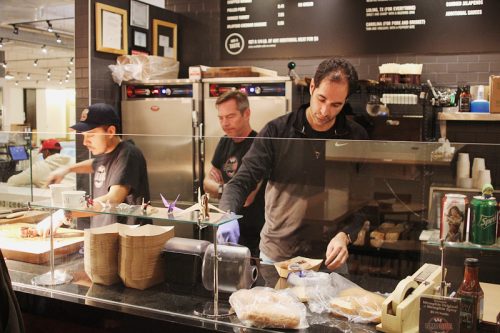
Barry Sorkin of Smoque
“This is what the whole concept was about,” Finkelman explains. “Here’s this group of people who live and work in the Loop, and these are our customers [at our other restaurants] at night and on the weekend, but down here, they have no avenue for finding great food. Most of the great food is in the neighborhoods, and bringing the neighborhood here—and treating the Loop like a neighborhood—no one had done that.”
“What we wanted to do was bring our best, our favorites, to the Loop from the outlying neighborhoods. We thought every place in Revival Hall should be some place that we were telling our friends about,” Finkelman says. “And that’s exactly what Smoque is.”
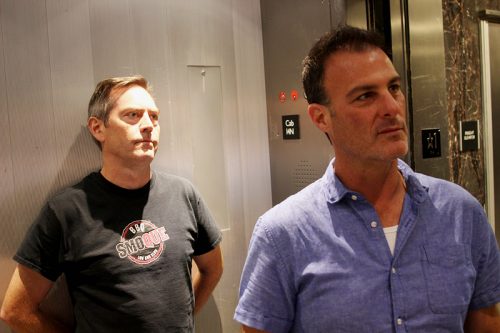
Riding to the 20th floor with Mike McDermott of Smoque and Bruce Finkelman of 16″ On Center
SORKIN WANTED TO INSTALL THE SAME smoker as they have (three of, by now) at the Pulaski location—a Southern Pride with a rotating oven similar to a pizza oven, gas for heat but a smoke box with live wood fire for flavor. There were two obvious reasons to stick with the Southern Pride—they knew how to crank out the meat on it, and “the city is okay with this,” Sorkin says. “They’re not so okay with a lot of the other devices that are available.”
“It’s very difficult for the city when there aren’t previous things to look at,” Finkelman says. “I think we got to the point where there just wasn’t any reason not to let us do what we wanted to do—we’d followed all the codes, we’d done everything we had to do from a health perspective, from a safety perspective. So I think at that point, it was just, okay, you guys can do it.”
So they got the go-ahead to install a smoker in a prep space on the top floor, which they share with some bakery equipment used by Mindy Segal. “The funny thing is, the other half of the floor is the fitness center,” says Smoque co-owner Mike McDermott, who focused on the Revival Hall location for the last year or so. “So you’re going to work out, and smell baked goods and barbecue.”
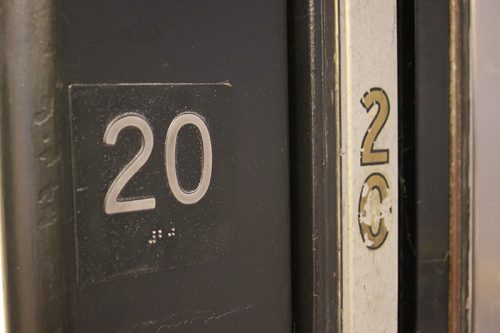
As outlandish as the idea of putting a smoker on the 20th floor and pumping hardwood smoke into the Loop air twenty stories up may sound, it was acceptable in a way smoking on the main floor would not have been. Sorkin says, “The city does not like you to share any black iron ductwork—” that is, the vents over a standard stove or oven—”with a solid fuel piece of equipment, and a fryer.”
Instead, the smoke gets a short path out of the top of the building, while the smoked meat takes a 20-floor ride on a service elevator several times a day to keep the stand stocked and ready to serve. (You’ll never ride with a cart full of barbecue if you live in the building, though they are allowed use of a backup—a freight elevator—in case their main one has to be repaired.)
Sorkin says the capacity of the single smoker “is about right. We’re pretty much packing it full every day, and we run through pretty much everything we cook every day. Which in some respects is perfect—when we first opened in our other location, we had one smoker, and we were selling out every day, and we thought, man, we want more capacity. And then we built more capacity—and suddenly we had to forecast and be right, or you really overcook.”
“Then you actually have to sell stuff,” Finkelman says. “Takes all the fun out of it.”
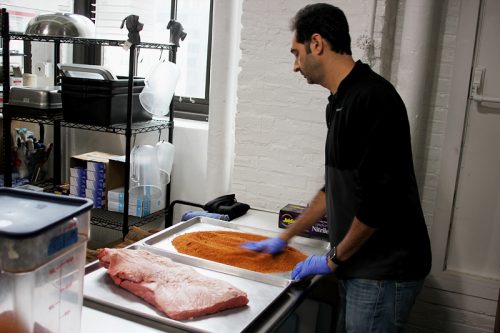
Barry seasoning briskets
Bringing Smoque to a primarily lunch audience in the Loop resulted in some operational changes from the original location—of, Sorkin says, “The ‘if we knew then what we know now’ kind.” They modified the menu—removing ribs (too heavy for lunch) and adding turkey, getting rid of French fries (available elsewhere, and they slow down the line) in favor of potato salad.
McDermott says they stripped down how the line works: “We did it more like a meat market style, you talk to the meat cutter, he takes your order and gives you exactly what you want. There are no tickets, like we have in the original Smoque. As soon as it’s made, you’re gone. We knew in this environment, because you have that window of 2 or 3 hours where you really have to punch out a lot of orders, we wanted to model it that way. And so far it’s worked really well.”
It wasn’t ever our point to be food hall people—we just wanted to do something really cool in this area.
Now, the day starts the night before, just as food service is shutting down at 7 pm. “We usually put the brisket on about 7,” McDermott says. “Then our kitchen manager is here at 5 in the morning, to start testing briskets for doneness. Usually they finish up between ten hours on the short side and 14 on the long side, and the only way to know is to feel each one of them.”
“There’s a nice kind of gelatinous jiggle that they give you, when they’re about ready,” he says.
Pork goes on at the same time as brisket, and both come off in stages between 5 and 8. As space is freed up, turkey takes its place. “It comes out just in time for lunch,” Sorkin says. He looks past the smoker, to the city outside. “A pit room with a view. You don’t see that very often,” he says.

Smoque just uses dry rub, with no other coating like mustard. “They say it helps the rub stick. The rub sticks fine. They say it helps bark develop. Well, we have plenty of bark.”
IT SEEMS LIKE A PRETTY well-worked out system. So I ask, innocently, hoping I might catch them somebody off guard—you planning to do this anywhere else? Food halls are popping up all over, after all…
Neither Sorkin nor Finkelman bites. “There’s only one Bruce,” Sorkin says.
“When Craig and I started this, it wasn’t that we wanted to go into the food hall business,” Finkelman says. “We feel strongly about this area and have a real connection to this community. It’s great to see that food halls have become a thing of the future, and we’re all pretty honored that people are looking at what we’ve done here. We get phone calls every day, from all over the country. But it wasn’t ever our point to be food hall people—we just wanted to do something really cool in this area.”
“One of the things about Smoque on Pulaski is that it was a great location for a destination restaurant. It’s 15 minutes from a lot of people,” says McDermott. “And this location is the best location for a food hall in the city of Chicago.”
“We had to look at this in terms of vertical populations,” Finkelman says. “There’s 5000 people in this building, who have to eat somewhere.”
“And the difference is, they looked at it as an amenity for the people living here,” McDermott says. “So many people we talk to, they look at it as, you should be paying us for access to the customer base.”

Well, yes, restaurants do in fact have to pay rent for a good location. But hearing that is a sign of a bigger story—food halls have the potential to change a lot of the economics of the restaurant business. At a time when everyone is complaining about how tight running a restaurant can be, the economics (and sociology) of the food hall—restaurants looked at as an amenity for marketing real estate, while the property owner manages a lot of the boring parts of running a restaurant, leaving the restaurant owner to focus on good product and a hip brand—sounds pretty great.
“For us, it’s really ideal,” says Sorkin. “We come and we cook and we serve and we go home. All the unpleasantries of running a restaurant taken care of by these guys.”
“It was really part of the idea, to take the headaches of the brick and mortar out of the hands of the chefs, and let them do what they want to do,” says Finkelman.
With several other food halls announced for the Chicago area alone, somebody’s going to see if there’s more than one best location for a food hall in Chicago, anyway. But before I can commit this story to pixels, there’s one fact I want to check. Do they really know that this is, in fact, the highest barbecue restaurant smoker in the world?
“Prove that we’re not,” says Sorkin. “Find a taller one. And then we’ll have to build an antenna on top of the smoker, to get the title back.”
Michael Gebert is the tallest editor at Fooditor.
Latest
Join the Discussion
After you comment, click Post. If you're not already logged in you will be asked to log in or register with Disqus.





